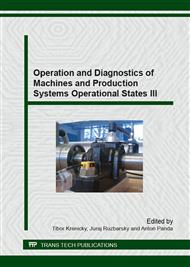[1]
P. Valášek, J. Žarnovský, M. Müller, Thermoset Composite on Basis of Recycled Rubber, Advanced Materials Research 801 (2013) 1022-6680.
DOI: 10.4028/www.scientific.net/amr.801.67
Google Scholar
[2]
M. Müller, P. Valášek, Abrasive wear effect on Polyethylene, Polyamide 6 and polymeric particle composites, Manufacturing Technology 12 (2012) 55-59.
DOI: 10.21062/ujep/x.2012/a/1213-2489/mt/12/1/55
Google Scholar
[3]
J. Kejval, M. Müller, Mechanical properties of multi-component polymeric composite with particles Al2O3/SiC, Scientia Agriculturae Bohemica 44 (2013) 237-242.
DOI: 10.7160/sab.2013.440407
Google Scholar
[4]
P. Valášek, M. Müller, Recyclation of waste microparticles in interaction with polymeric matrix - Multiphase composite, in: Proc. of Engineering for Rural Development 23th May 2013, Jelgava. Latvian University of Agriculture, Jelgava, 2013, pp.238-243.
Google Scholar
[5]
D. Briassoulis, et al., Degradation Characterization of Agricultural Low-density Polyethylene Films, Biosystems Engineering 88 (2004) 131-143.
DOI: 10.1016/j.biosystemseng.2004.02.010
Google Scholar
[6]
Aamer Ali Shah et al., Biological degradation of plastics: A comprehesive review, Biotechnology advances 26 (2008) 246-265.
Google Scholar
[7]
R. Siddique, J. Khatib, I. Kaur, I., Use of recycled plastic in concrete: A review, Waste Management 28 (2008) 1835-1852.
DOI: 10.1016/j.wasman.2007.09.011
Google Scholar
[8]
P. Valášek, M. Müller, Polyurethane resins filled with inorganic waste particles, Manufacturing Technology 13 (2013) 241-247.
DOI: 10.21062/ujep/x.2013/a/1213-2489/mt/13/2/241
Google Scholar
[9]
Y. Fang, M. Zhan, Y. Wang, The status of recycling of waste rubber, Materials and Design 22 (2000) 123-127.
Google Scholar
[10]
M.R. Dadfar, F. Ghadami, Effect of rubber modification on fracture toughness properties of glass reinforced hot cured epoxy, Materials and Design 47 (2013) 16-20.
DOI: 10.1016/j.matdes.2012.12.035
Google Scholar
[11]
Shi Ai Xu, Gong Tao Wang, J., J. Yiu Wing Mai, Effect of hybridization of liquid rubber and nanosilica particles on the morphology, mechanical properties, and fracture toughness of epoxy composites, Material Science 48 (2013) 3546-3556.
DOI: 10.1007/s10853-013-7149-4
Google Scholar
[12]
P. Valášek, Mechanical Properties of Epoxy Resins Filled with Waste Rubber Powder, Manufacturing technology 14 (2014) 632-637.
DOI: 10.21062/ujep/x.2014/a/1213-2489/mt/14/4/632
Google Scholar
[13]
P. Valášek, M. Müller, EPDM rubber material utilization in epoxy composite systems, Agronomy Research 12 (2014) 291-298.
Google Scholar
[14]
P. Valášek, M. Müller, J. Ružbarský, Using recycled rubber particles as filler of polymers, Applied Mechanics and Materials 616 (2014) 260-267.
DOI: 10.4028/www.scientific.net/amm.616.260
Google Scholar
[15]
M. Muller, Metal waste processing plants (Zpracovny nekovového odpadu), CULS, 2008 (in Czech).
Google Scholar
[16]
M. Muller, K. Hykšová, P. Valášek, Packing optimization with emphasis on sustainable progress in sphere of waste production, in: Proc. of Engineering for Rural Development 24th May 2012, Jelgava. Latvian University of Agriculture, Jelgava, 2012, pp.173-178.
Google Scholar
[17]
T. Krenický, Implementation of Virtual Instrumentation for Machinery Monitoring, in: Scientific Papers: Operation and Diagnostics of Machines and Production Systems Operational States: Vol. 4, RAM-Verlag, Lüdenscheid, 2011, pp.5-8.
Google Scholar
[18]
M. Müller., P. Zadrobílek, M. Brožek, A. Nováková, J. Malaťák, Manual press with perforator UPV, CZ 21450 U1, (2010).
Google Scholar
[19]
M. Müller, Pedal-operated press with perforator UPV, CZ 21875 Cz, (2011).
Google Scholar


